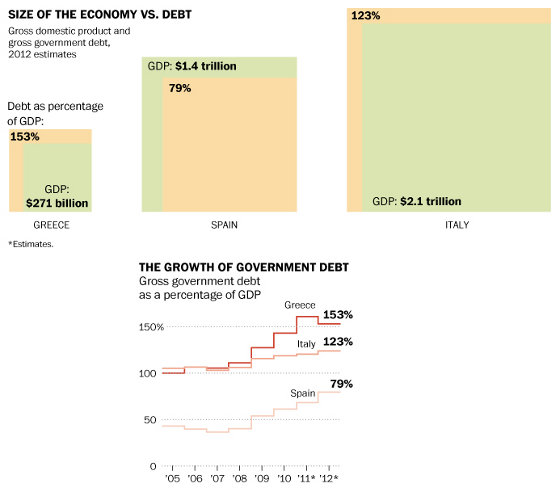Anche se normalmente parlo poco di economia su queste pagine, voglio segnalare questo articolo di Bloomberg che mi ha colpito parecchio e dal quale emerge la visione che gli analisti finanziari hanno del nostro Paese.
Ho lasciato tutto in lingua inglese per evitare di distorcerne, anche involontariamente, il significato.
Inizia dicendo:
“Investors will pay attention to every bit of information before deciding to buy or to sell Italian bonds.
Italy has 2 trillion euros of debt, more as a share of its economy than any developed nation other than Greece and Japan.
The Treasury has to sell more than 35 billion euros of bonds and bills per month — more than the annual output of each of the three smallest euro members, Cyprus, Estonia and Malta.”
Però aggiunge anche:
“Italy is on track to bring its budget deficit within the European Union limit of 3 percent of gross domestic product this year and the country is already running a surplus before interest payments, meaning its debt will soon peak at about 120 percent of GDP. The jobless rate is less than half of Spain’s 24 percent, and Italy didn’t suffer a real estate bust, leaving its banks healthy by southern European standards.
Italy’s total debt of more than twice Spain’s has given investors pause, especially in a country where economic growth has lagged the EU average for more than a decade. The euro region’s third-biggest economy, Italy is set to contract 1.7 percent this year, more than the 1.6 percent in Spain, the Organization for Economic Cooperation and Development estimates.
Italy’s debt load had traditionally led the country to be perceived as a bigger credit risk than Spain. At the start of this year, Italy’s 10-year bond yielded 202 basis points more than that of Spain. As the extent of Spain’s banking woes became more evident and the country was forced to raise its deficit target, that spread reversed and now Spain’s 10-year yields 48 points more than Italy’s.“
“The ECB will probably have to restart buying bonds but there will be a lot of sellers into that of people who are worried that Spain is the next Greece and Italy the next Spain.”
Per capirci meglio, l’andamento dei titoli decennali italiani sarebbe questo. Tocchiamo ferro?
[UPDATE 14.06.2012] Ho visto che il Washington Post ha pubblicato alcuni grafici che probabilmente mostrano ancora più chiaramente la posizione attuale e il trend dell’Italia nei confronti di Grecia e Spagna.
I quadrati verdi indicano il PIL di ognuna delle tre nazioni (indicato con GDP, Gross Domestic Product), mentre i quadrati color avorio rappresentano l’indebitamento.
Se ci fermassimo all’osservazione dei quadrilateri, l’impressione che avremmo è quella di un Paese a pochi centimetri dal baratro finanziario, una situazione decisamente peggiore di quella della Spagna.
E in valore assoluto è esattamente così.
Osservando successivamente il trend, vediamo invece che il debito pubblico italiano, pur continuando a crescere costantemente da cinque anni a questa parte (il che è estremamente preoccupante visto che, come dicevamo, il nostro problema principale è proprio l’abbassamento del debito), desta meno preoccupazione di quello della Spagna che nel medesimo periodo ha continuato a procedere a velocità doppia.
A meno di inversioni di tendenza, l’indebitamento spagnolo dovrebbe presto superare il rispettivo PIL.
E anche questo non è un bene, per l’Italia.















